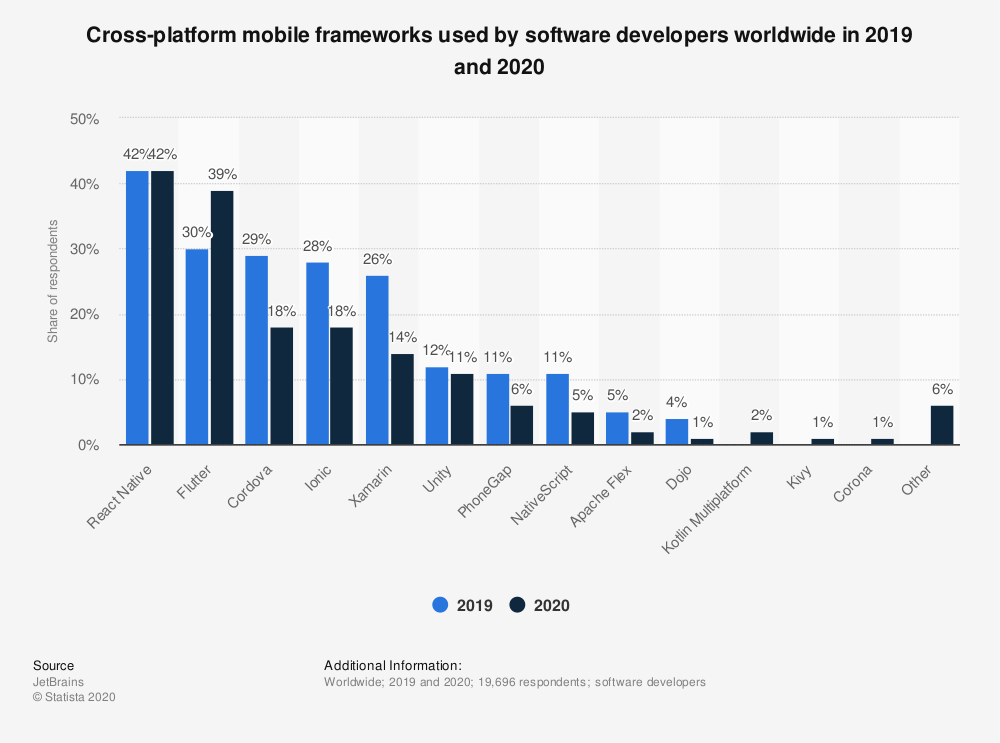
The very first decision you must make when creating a mobile app is whether it will be native or hybrid. This decision could not only be the difference between the success or failure of your project; it could also have a big impact on your business as a whole.
To date, we have worked with native and hybrid mobile apps with use cases ranging from streaming platforms to legal billing data analysis. Some of our clients are big businesses while others are startups trying to enter the mobile market, and we’ve even worked with nonprofit organizations. Thus, we always have to look for the solution that fits the product and the budget best, creating a valuable, quality app with the resources available. Here, the difference between native and hybrid mobile apps plays a crucial role. Hence, I’m going to share with you the elements you must consider when choosing whether your app will be native or hybrid.
Native vs. hybrid, what’s the difference?
If you google it, you’ll see that this debate has been going for years, and some people even thought it was over. However, today we have many more elements to consider than we did before, as mobile development continues to evolve.

The first thing we must know to determine whether we will take one side or the other is the concept of these approaches themselves. So, let’s analyze the technical differences between native, web, and hybrid apps.
Native apps
Native app development is the design of mobile apps for a single operating system like Android, iOS, or Windows. Unlike hybrid or web applications that run on a browser, users download native apps from app stores like Google Play Store or Apple’s App Store.
To develop a native mobile app that works in more than one OS, you need a team with a cross-cutting skill set experienced in both Android and iOS. Android apps are written in Kotlin or Java, and iOS apps require Swift or Objective-C. An app built with Kotlin or Java won’t run on Apple devices, and vice-versa. However, native apps follow the UI controls and layouts of each OS, providing a seamless experience and making users feel like the app is part of the OS itself. Moreover, apps that are fully integrated into the OS perform better in terms of latency, reliability, and continuity. These benefits of native development are the most appealing, and we’ll discuss them more later.
Web apps
Web application development involves building apps that run in a browser. Although it could seem apps developed using this approach would require an active internet connection to work, these applications have a layer of “service workers” that capture connection problems, making it possible to manage the user experience when there is no connection. This type of application is written in HTML/JavaScript and not in native languages.
Web applications have a single codebase and function as a web page. They don’t require platform-specific programmers but do require engineers who know web technology. Web applications can be distributed via a link and don’t have to go through the approval process for distribution in the marketplaces of each platform.
Hybrid apps
Hybrid apps are a combination of native and web development. The core of the application is written using web technologies like HTML, CSS, and JavaScript, and is then wrapped within a native app.
Hybrid mobile apps are wrapped as native apps through frameworks like Flutter and Ionic. These platforms allow plugins to access device features to overcome the limitations of web-only applications. These solutions create a native shell that offers the ability to develop and publish apps that can be submitted to each platform’s app store for sale.
The core of a hybrid-mobile app is still just an application that’s written with HTML, CSS, and JavaScript. However, instead of operating within the user’s browser, it runs within a native application and its embedded browser, which is essentially invisible to the user. For example, a hybrid app would use WKWebView to display an application on iOS, while on Android it would use the WebView element to perform the same function.
In summary, native apps are apps developed for a specific mobile OS, and web apps can be used on any OS through a browser. Hybrid apps combine the elements of both native apps and web applications. Engineers develop hybrid apps using HTML5 and JavaScript within a native container, which loads and displays most of the information on the page as the user navigates it.
Is good user experience exclusive of native apps?
Many years ago, when mobile development took its first steps, apps were designed to put modern electronic functions — such as storing data, creating reminders, and scheduling — into our hands. User experience wasn’t that important. Now app use cases continue to evolve and user experience and interface design are both highly critical.
In fact, user experience is one of the most analyzed elements within the hybrid vs. native controversy. A common misconception is that only native apps can achieve 5-star performance, and the use of hybrid apps or web applications will cause users and businesses to suffer.
Some believe this notion because, as we mentioned before, native apps follow the unique layouts and controls of their respective OS and, because operating systems behave quite differently, creating a single app for both results in a high learning curve for all users. Is this true? Is good UX only possible with native apps?
Quick answer: no. Although many people underrate the robust functionality and speed of hybrid app development, hybrid app frameworks are evolving drastically, and thousands of apps already prove that hybrid development can perform as well as native development.
When I mention Instagram, Gmail, Uber, and Twitter, do you think of poorly performing apps with a high learning curve? These apps are hybrid, yet performance is the least of their worries. But, if hybrid apps can indeed perform like native, why do so many people doubt it? And how can you develop a high-performing hybrid app?
The answer to both of these questions is skill. It takes a highly-skilled, dedicated team to create a successful hybrid app. Some people may recommend against it because it’s easier to develop an Android app using the Android guidelines and layouts than to think outside the box and create a seamless user experience for users of more than one OS.
However, there is denying that hybrid apps are the future of mobile development. Not only can they perform like a native application; they are also faster to build and easier to maintain.
There are a few exceptions, though, so let’s look at some specific examples of how to choose between native or hybrid app development.
How to make a rewarding decision
There are times when it’s necessary to work natively to succeed, as was the case with one client whom we helped to develop a streaming platform. When we started working with the client, the initial streaming service was already built and had a wide scope of platforms including web, iOS, Android, Fire TV, Roku, and smart TVs like Samsung, Vizio, Vewd, and LG. But the service had systematic failures in the consistency of its data, prompting a high volume of customer support requests. Thus, we first advised redeveloping an existing Android app, fusing the Android codebase with Fire TV, which would drastically reduce costs and improve the quality of the product by working together. We also decided to develop a core React app with a smart TV user interface (UI) that we use for all smart TVs, and it proved to be quite beneficial.
But native development is not always the way to go. We once had a client, a startup, that failed to launch its product as it spent all its budget making native apps for iOS and Android. It would have been a different story if it had opted for hybrid development. While developing hybrid apps, we have confirmed that there are little things a native app can do that a hybrid app can’t.
Developing native apps can be very challenging and demanding, as building them requires starting from scratch for each OS, working with teams of developers separately, yet managing to create a cohesive service that works the same in both OS. Additionally, our years of experience recruiting mobile developers have confirmed that hiring quality native mobile developers is much more expensive than hiring highly-skilled web developers.
Another case we handled involved a client developing an app that provides a connected classroom to help students from pre-K to fourth grade learn to read using a sight-based learning algorithm. At first, we developed it and launched it for both Android and iOS, but after some time on the market, the client realized he could cut maintenance costs by half and achieve the same results, so he decided to discard the apps and, along with our team, start working on a Progressive Web App (PWAs are powered by Google).
We are currently working on a hybrid app using React Native called Safe Xtract. The app is focused on helping people define vehicle recovery standards. The developers created a native app years ago that they could neither maintain nor scale because of the high development rates. But now, using React Native, they are able to do it, and their high level of satisfaction let us know we made the right choice.
Hybrid development frameworks keep evolving as more people see the benefits of unifying their work into a single, cross-platform app while keeping the same quality and originality of native apps. Except for a few rare exceptions, there is no reason to discard hybrid frameworks as an ideal app development solution, and we will keep taking the lead on showing our clients how to benefit from it as well.
Native, web, and hybrid app development: summary
Are you ready to make a decision? Native app development can be draining for your project and your business, which is why you must consider the purpose of your app and the functionalities it will require to achieve your goals. Web apps allow users to interact with the app through shopping carts, online forms, etc., but have limited access to functionalities within the device and little to no connection to other apps within it.
Hybrid apps are a combination of both native and web development. These applications get full access to the mobile device’s features by using plugins, have lower development costs, and are easier to maintain.
With these factors in mind, you will be able to choose the approach that suits you best. Even taking into consideration the few exceptions, there is almost no limit to the things you can do through hybrid app development, and the limits will continue to decrease as hybrid-development frameworks evolve and knowledge on the subject improves.
Michel decided to dedicate his life to the software industry at a very short age. He graduated with a degree in Computer Science and Mathematics. Since founding BEON, he and Damian have worked hard to establish it as an elite company, providing the best engineer LATAM talent to major U.S. companies.
Explore our
Explaining Agile: Examples in Real Life And Core Concepts.
Whoever said that being a project manager is easy has never had that responsibility. ..
Founding an International Software Agency—The Story of BEON’s Founders
When we learn about successful startups, we rarely hear about the obstacles and pitfalls the founders faced as these businesses grew. ..
API Security: Top 10 Most Common Risks and Their Prevention
With so many people depending on them, risk management regarding APIs is becoming an increasingly relevant topic in the software industry. ..






